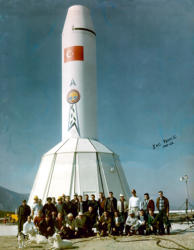
HISTORY - Page 87
could support the launching of the 21-pound VANGUARD sphere. The Army's reply: by June 1958, using a
vehicle such as the JUPITER. However, before that time, launching was possible by repackaging the
instrumentation into a cylindrical container and using the JUPITER C’s. Proposals were made to launch two
vehicles of this type; one in February 1958 and one in April. In fact, during the month of October 1957, the
Secretary of the Army outlined a multi-phase satellite program. The first would consist of the launchings
just mentioned. The second would involve launching five JUPITER C satellites carrying television
equipment, in view of the fact that the Russians rejected President Eisenhower's "Open Skies" proposal.
And the third phase would be a 300-pound surveillance satellite, using the JUPITER as a booster
133
.
On 8 November 1957, the Secretary of Defense gave his permission for the Army to plan for the launching
of two JUPITER C's by March 1958, and $3.5 million was made available. By 20 November 1957, the Secretary
of the Army was able to provide launching dates of 30 January and 6 March 1958
134
.
As communication media of all types have recorded, EXPLORER I, the Free World's first artificial satellite,
was placed in orbit on 31 January 1958. The hardware used was essentially the same that had been
available during 1956, but the United States had missed the opportunity of a "first."
_____________________________







133. Memo, S/A to S/D, 7 Oct 57, subj: Soviet Sat; Memo, S/A to S/D, 23 Oct 57, subj: Army Spt of VANGUARD Pro; Memo, S/A to Spec Asst for Guided Msls, DOD, subj: Mil Sat, Hist Off
files.
134. Memo, S/D to S/A, 8 Nov 57, subj: Scientific Sat Pro; Memo, S/A to S/D, subj: Scientific Sat Pro, Hist Off files.



Jupiter SM-78 Weapon System
I&C Team 2, Çigli AB, Turkey 1961-1962 Chrysler Corporation Missile Division

HISTORY - Page 88
could support the launching of the 21-pound
VANGUARD sphere. The Army's reply: by June
1958, using a vehicle such as the JUPITER.
However, before that time, launching was
possible by repackaging the instrumentation into
a cylindrical container and using the JUPITER C’s.
Proposals were made to launch two vehicles of
this type; one in February 1958 and one in April.
In fact, during the month of October 1957, the
Secretary of the Army outlined a multi-phase
satellite program. The first would consist of the
launchings just mentioned. The second would
involve launching five JUPITER C satellites
carrying television equipment, in view of the fact
that the Russians rejected President
Eisenhower's "Open Skies" proposal. And the
third phase would be a 300-pound surveillance
satellite, using the JUPITER as a booster
133
.
On 8 November 1957, the Secretary of Defense
gave his permission for the Army to plan for the
launching of two JUPITER C's by March 1958, and
$3.5 million was made available. By 20 November
1957, the Secretary of the Army was able to
provide launching dates of 30 January and 6
March 1958
134
.
As communication media of all types have
recorded, EXPLORER I, the Free World's first
artificial satellite, was placed in orbit on 31
January 1958. The hardware used was essentially
the same that had been available during 1956,
but the United States had missed the opportunity
of a "first."
_____________________________
133. Memo, S/A to S/D, 7 Oct 57, subj: Soviet Sat; Memo, S/A to S/D, 23 Oct 57, subj: Army Spt
of VANGUARD Pro; Memo, S/A to Spec Asst for Guided Msls, DOD, subj: Mil Sat, Hist Off files.
134. Memo, S/D to S/A, 8 Nov 57, subj: Scientific Sat Pro; Memo, S/A to S/D, subj: Scientific Sat
Pro, Hist Off files.





















